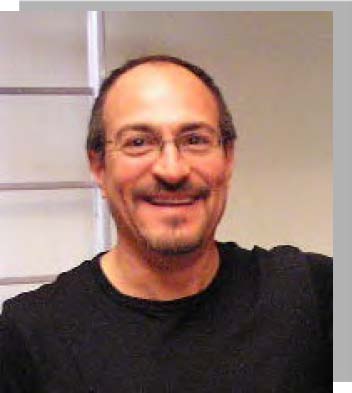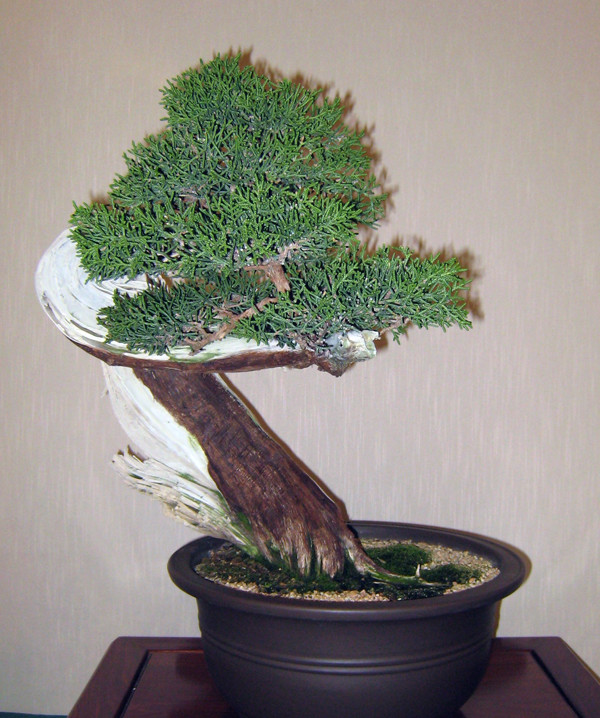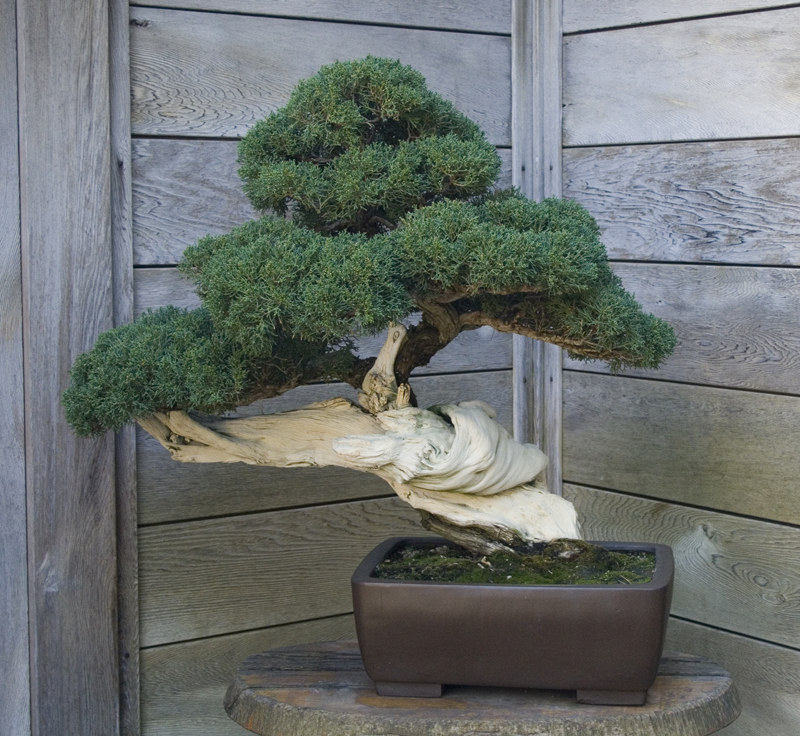September 2008 Newsletter
President’s Message
Time Invested Will Pay Dividends
By Ken Fuentes
As we get closer to our 5th Annual Exhibition at the Gardens of the World in Thousand Oaks, we need to pull our resources together to make this show our best ever. To date we have eight members who have signed up on the “Show Tree List” for a total of 15 trees. This is not enough—we need more.
|
Also, we want to make sure we include trees from both novice and experienced members and every-one in between, but most of the trees on our current list are from our more experienced members. So we need additional trees from both ends of the experience spectrum.
So here’s my “Presidential Challenge” for our September meeting on the 18th: Evaluate not only the trees that are in bonsai containers but also trees that are in nursery containers that are looking good and just need to be repotted.
There is enough time to repot before the show and—based upon the variety—to be careful to protect the tree for a few weeks from the hottest part of the day.
In addition to more trees, we need more publicity. Marj Branson will bring handouts that can be posted in your local meeting places. Please get management approval if you are posting the flyer inside a business because the policy usually is to remove them if they are not approved.
Each member has to view this show as if it were his or her own. We have members that always bring in trees and we thank them for their support, but we would like more members to contribute. If you invest as much time as you can to make a contribution, this without question will be the best show to date.
Club Events
CVBS’s 5th Annual Exhibition Is Upon Us
By Marj
Branson Our 5th Annual Exhibition will be here before we realize. It is the first weekend of October, Saturday and Sunday, October 4 and 5, at Gardens of the World in Thousand Oaks. To make it happen, we have a few logistic items to organize and volunteers to help set up, run, and break down the show. They are as follows:
- Tables: We need 6 tables (each at least 5 feet long). They need to be delivered to the Gardens of the World by Friday at 3:00 PM. If you have provided them in the past can you do so again?
- Tree Labels: Please provide Marj Branson with the proper names of the trees you plan to exhibit. You can supply your list at our September meeting.
- Work Program: We will require help on Friday afternoon, all day Saturday, and all day Sunday. The shifts are:
- Friday: 3:00 PM to 5:00 PM: Set up the tables and the exhibition (signs, tree labels, etc.).
- Saturday: Morning: 9:00 AM to 12:00 Noon. After-noon: 12:00 Noon to 4:00 PM
- Sunday: Morning: 9:00 AM to 12:00 Noon. After-noon: 12:00 Noon to 4:00 PM
- Volunteer Work List: We will be circulating the work list at our September meeting and ask members to sign up for the time and task that best suits them.
- During the Exhibition (Saturday and Sunday) there are several tasks that need to be performed:
- Greet and talk to the public about Bonsai and the club
- Answer questions
- Keep an eye on our exhibition
- Help visitors find the demonstrations
- Assist the demonstrators, if requested
- Tend to the trees
- Work Sunday late afternoon, 4:00 PM to 5:00 PM:
- Breakdown the exhibition
- Clean demonstration areas
- Clean exhibition room and kitchen
The exhibition and demonstrations will be held at the Gardens of the World, 2001 Thousand Oaks Boulevard, Thousand Oaks (the same time and place as last year). The exhibition will be in the Re-source Center Saturday and Sunday from 9:00 AM to 4:00 PM.
The demonstrations will be held at the Bandstand on Saturday and Sunday at 11:00 AM and 2:00 PM
Please bring your trees to the Resource Center on Friday between 3:00 PM and 5:00 PM. If you cannot bring them at this time, please advise the committee as we will arrange to take in the trees prior to the Garden opening on Saturday.
Breakdown will be between 4:00 PM and 5:00 PM on Sunday. Trees and tables can be collected at that time.
During the Exhibition, parking in the top parking lot is restricted to only those working at the Exhibition or Demonstrations. Street parking on Thousand Oaks Boulevard (not on site) is available to all visitors.
If you are not able to attend our September meeting, please con-tact Marj Branson regarding trees and tasks you can provide.
Program Notes
Barrett To Help Prepare Trees for 5th Annual CVBS Exhibition
By David E. Whiteside
If you plan to enter one or more of your trees in the Conejo Valley Bonsai Society’s 5th Annual Exhibition October 4 – 5, bring them to our September club meeting on the 18th. Club officers want to re-view all trees prior to the exhibition to ensure that we show only proper material. In addition, bonsai master teacher Jim Barrett will review all the trees and explain what needs to be done to prepare them properly for exhibition.
Barrett has been involved with bonsai since 1954, when he was living in the San Gabriel Valley. He started his collection with two Japanese black pines and two junipers purchased from the legendary San Gabriel Nursery. One of those trees reportedly is still living, in a private collection on the East Coast.
Early on, Jim became active in local bonsai circles and then in the California bonsai community. He has been president of many bon-sai organizations. He was the first president of the Golden State Bonsai Federation (GSBF), president of Bonsai Clubs International, and president of a number of local clubs. He is a member of the Descanso Bonsai Society, the Santa Anita Bonsai Society, and the California Bonsai Society.
Throughout his bonsai career, Jim has sought new challenges. In the 1960s, he started teaching bonsai and continues to teach to this day. While an excellent teacher for all bonsai material, he specializes in deciduous material, especially elms. He travels worldwide to teach bonsai classes and demonstrations and has been a major headliner in almost all worldwide conventions, except Japan.
Again in the mid-1970s, Jim stepped up to a new challenge, this time to create affordable bonsai pots in the Japanese tradition. He has his own kilns to fire his pots, and has developed some of his own glazes. Several of his pots hold trees at the National Collection in Washington, D.C. Jim also has a tree in the National Collection.
Currently, Jim says he’s willing to travel anywhere to teach bon-sai students of all levels from beginner to advanced. He generally teaches small classes with no more than eight to ten students. He teaches regular classes at his home-based business in Arcadia, and several members of the Conejo Valley Bonsai Society study with him. Jim also offers pinch-pot classes and teaches very small classes geared to ways to teach the Bonsai Basics by GSBF. He is also a regular contributor to the Descanso Bonsai Society newsletter and to our own newsletter.
Aided by his wife, Helen, Jim is a regular vendor at major bonsai conventions, where he sells a variety of bonsai-related items but especially his pots.
Japanese Culture Day
CVBS To Exhibit Bonsai at Japanese American Citizens League Event
By Paul Centeno
The Conejo Valley Bonsai Society will display some of its members’ finest bonsai at the 18th Annual Japanese Culture Day Festival sponsored by the Ventura County chapter of the Japanese American Citizens League. The event will be Sunday, October 12, 2008, from 1:00 – 4:00 PM. All members are encouraged to participate and attend.
Founded in 1929, the JACL lays claim to being the oldest and largest Asian American civil rights organization in the United States. In addition to monitoring and responding to issues that enhance or threaten the civil and human rights of all Americans, JACL seeks “to promote a world that honors diversity by respecting values of fairness, equality, and social justice,” according to its national Web site vision statement.
The purpose of the Japanese Culture Day Festival “is to educate the public on Japanese culture and arts,” Mariko Chilcott, 2008 chairperson for the local event, explained in an e-mail. “We provide Japanese food sample plates, dance, martial arts, crafts, paintings, etc.”
This year’s event will be at the Camarillo Community Center at Carmen Drive and Burnley Street in Camarillo.
Ken Fuentes, Marj Branson, and I plan to be there from setup (at 11:00 AM) until after the Festival closes at 4:00 PM. Ken, Marj, Nat Stein, and I already plan to contribute trees, but we’d like to have a wider representation if suitable material is available.
We will select more trees from those shown in our coming Annual Exhibition at the Gardens of the World and see if their owners will participate. All CVBS participants will need to bring their trees for the set-up on the 12th and come back at 4:00 PM to pick up their trees.
Barrett’s Bonsai Tips
September Is Time To Think Ahead
By Jim Barrett
Although fall is approaching, hot, dry days are still a good possibility.
|
Black pines should also be pruned, leaving one, two, or three of the new candles that have grown from the terminals left when they were pruned in June or July. What candles you choose to keep will be determined by your design goal for each tree. If you have an instructor, have him or her explain the procedure. Remove old needles, especially those hanging down.
Junipers may be trimmed to maintain their shape. Within reason, they may be trimmed rather drastically this month so that the new growth fills in to take the old growth’s place—a good practice once or twice a year to keep the bonsai shape we strive for.
Pruning hard will also give you an opportunity to wire the secondary and tertiary branches, a tedious but important task. However, try not to prune shimpaku too hard. They do not respond well to drastic foliage removal.
The next two months are important ones. What you do to your trees now will reflect favorably or unfavorably on your design next spring. Watch for heavy top growth on elms, Zelkova, and trident maples. Remove thick vertical and horizontal branches now so they have time to start healing before the trees go into dormancy.
Remember to watch for signs of disease and pests.
Start choosing your exhibition trees for next year, making sure to pick one or two more than you will show. This ensures that you will have what you need when the time comes. Besides, it will make you work harder to improve your best trees.
July Dig
Honeysuckle Dig Is a Success
By David E. Whiteside
On Saturday, July 26, Conejo Valley Bonsai Society members Bob Stradling and Kevin Kiely joined me at the Santa Paula home of my friends Joe and Carol Piros for a honey-suckle dig. The Piroses bought the house in 1983. “The oldest vine was in the ground and well established then,” Carol reports.
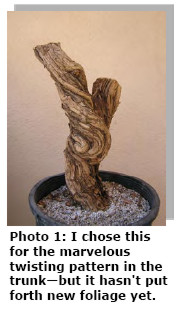 One vine that was 2 feet by 2 feet was taken out of its original location, cut into quarters with a chainsaw, and replanted along a fence, which is where we dug them up. “So 30-plus years on the vine is most likely very true!” Carol says.
One vine that was 2 feet by 2 feet was taken out of its original location, cut into quarters with a chainsaw, and replanted along a fence, which is where we dug them up. “So 30-plus years on the vine is most likely very true!” Carol says.
The wonderful thing about collecting bonsai material this way is that the price is right. It did take about five hours of some pretty hot and sweaty labor, but other than that the only cost directly attributable to the dig was the price of fuel to get there and home.
I didn’t have suitable containers for my honeysuckles, and wasn’t inclined to build boxes myself, so I did spend a few dollars at Green Thumb on planter boxes (see photos above) and some nursery cans. Still, I spent far less than a bonsai nursery would charge.
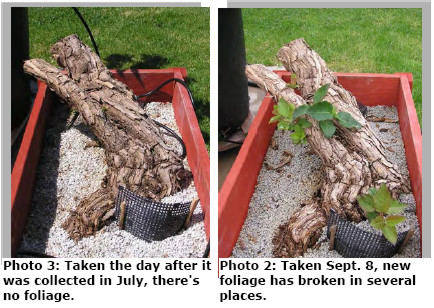
I took seven vines of varying degrees of potential home with me and four of them already have new foliage. Kevin collected four honeysuckle vines and reports that all have new growth. And Bob took one vine. “It’s 22 inches high and has a sharp bend in it of about 8 inches—it looks like a deformed number 7,” Bob reports. “It had a couple of shoots at the beginning on top but now there are several coming off of the trunk plus a lot more on top.”
One downside of this kind of dig is that we don’t know specifics about the species of honeysuckle we have. The honeysuckle genus (Lonicera) has nearly 200 species, so even once we have leaves and flowers, it will be a challenge to determine whether we have one of the shrub-like species that make for good bonsai, or one of the climbers that are more difficult to train in traditional bonsai styles.
According to one bonsai Web site, the British www.bonsai4me.-com, “shrubby Lonicera species include L. pileata and L. nitida which are both evergreen shrubs often used for hedging. … [B]oth species develop heavy, thick trunks and have light, fawn colored bark that peels off in strips revealing a smooth, light-colored under bark.”
That description fits what we collected very well, and it is encouraging that the Piroses’ original honeysuckle was a free-standing, shrub-like plant. But we’ll still have to wait for more foliage and blossoms to be sure.
Adding more confusion, the Integrated Taxonomic Information System (ITIS—see www.itis.gov) doesn’t list either nitida or pileata, so it’s going to be an interesting challenge to pin down these vines’ identity.
Nonetheless, the dig was a satisfying experience that at this point appears likely to produce some interesting bonsai for the three participants. We hope to organize more digs in the future.
GSBF Convention
Full Registration ‘Scholarship’ Deadline
By David E. Whiteside
If you are interested in receiving the Conejo Valley Bonsai Society’s Power of One “scholarship” for the Golden State Bonsai Federation’s 31st annual convention October 29 – November 2 in Modesto, the deadline for applying is coming up. The club’s board has set our October meeting as the cutoff for accepting applications.
The scholarship covers the cost of one full registration for the GSBF Convention, a $265 value that goes a long way to reduce the cost of attendance. Full registration provides you a pass to observe every demonstration plus admission as an observer to every work-shop. While you don’t get the hands-on experience of those who pay for full workshop participation, you do get the benefit of listening to the leader’s instructions and coaching tips.
Full registration also includes four meals (Friday dinner, Saturday lunch, Saturday night banquet, and Sunday lunch); purchased separately, these meals would cost $185.
You will also receive a full year subscription to Golden Statements, the GSBF monthly magazine (a $30 value).
Naturally, full registration allows admission to the bonsai and suiseki exhibits as well as the vendors’ area, where you can acquire virtually anything you need from tools to pots, books to display stands, and a wide variety of bonsai material from nursery stock to virtually complete bonsai.
For those who are relatively new to bonsai, take special note of the six Basic Classes, which are specially designed for first-time or new to bonsai enthusiast. Each student will receive a tree, pot, shears, soil, wire, and some other miscellaneous utensils—for just $35. As of September 8, there was still space in all Basic Classes.
The students will hear a brief history of bonsai and then be told about the care and maintenance of the tree they are about to create. They will learn how to prepare the pot, then transplant and secure the tree in the pot. They will learn how and why wiring may be applied to the tree. They will learn about branch and root trimming.
When the session is over, the student will have created his or her own living work of art. There are three Basic Classes work on box-woods, the other three on junipers. There is a Basic Class every half day, starting Thursday afternoon and running through Sunday morning.
If you have not been to a GSBF convention before, now is your opportunity to have the Conejo Valley Bonsai Society help you get there. You will still be responsible for your travel, hotel (rooms are $109 plus taxes per night—but you must register by October 9 to get this special convention rate; be sure to mention the GSBF Convention), other meals, and any workshops in which you wish to participate fully. Please let President Ken Fuentes know you are interested.
The convention is a great opportunity to learn from many experts in workshops, seminars, demonstrations, critiques of trees in the exhibit, and many informal conversations with both professionals and advanced amateurs.


